Hip-Hop and Graphic Counterculture
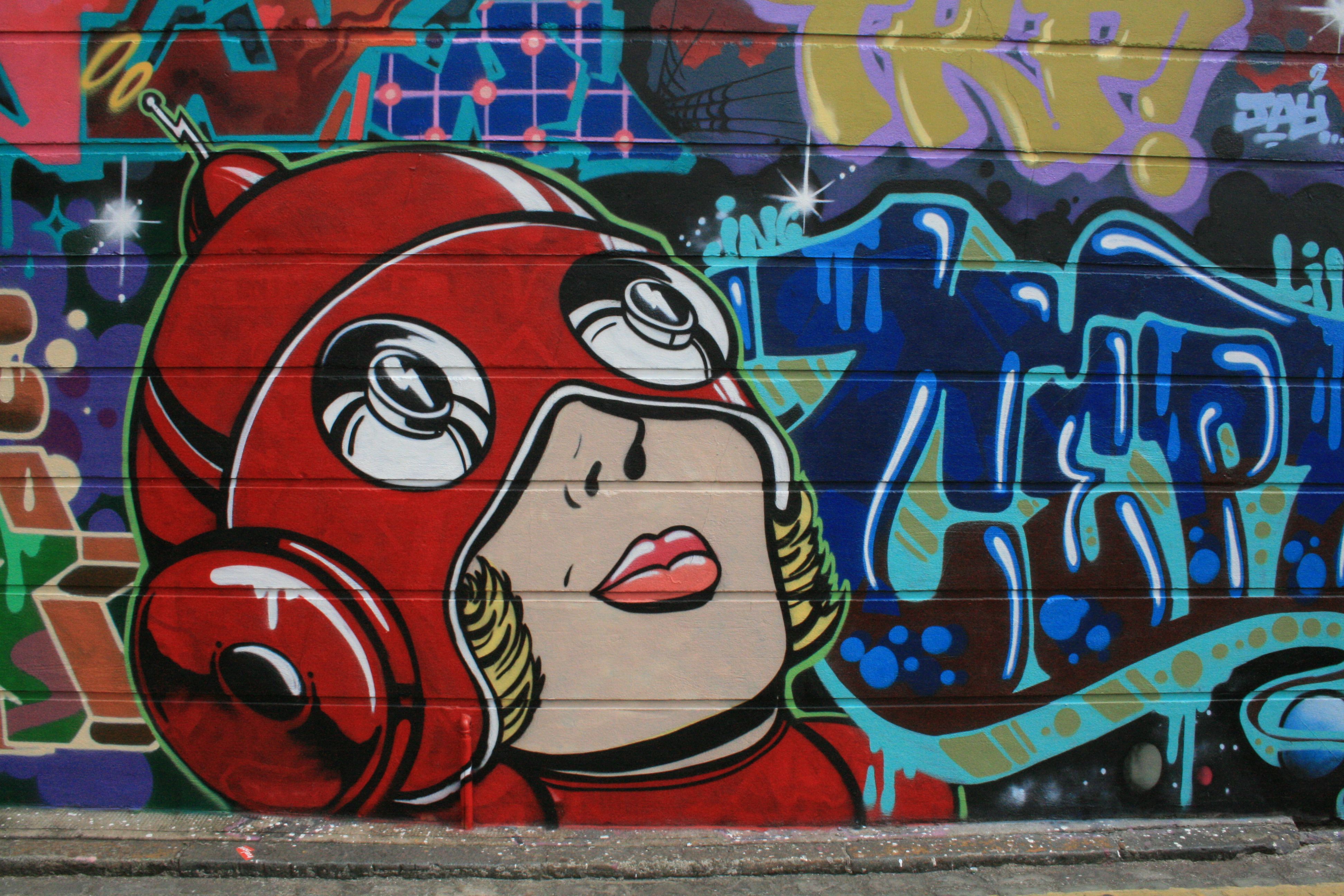.jpg)
Within the contemporary western urban culture there coexist several subgroups of youth culture; each one of them with its own identity and with legitimate and unmistakable expressions of that identity, each of them coming to possess even particular ideologies, and social constructions of their own reality. The Rockers for example are subdivided into multiple types, from the most aggressive as the Metal people (those who listen and make rock metal), to the most passive groups that come to propose sadness as an aesthetic foundation, the latter being the case of the Emo .
In this work we propose a reconstruction of the Hip-Hop culture and its artistic expressions from the ethnohistory, concentrating on Graffiti and its particular forms, explaining the fact that these manifestations are the graphic expression of a form of resistance and attack against the established, official, and socially accepted culture. The Hip-Hop culture is a form of subversion through art, sabotage, and often even through harsh or criminal behavior; completely conscious subversion on the part of its actors, and loaded with deep ideological signifiers, well rooted in time, shared globally, even with other urban cultural subgroups, and that evolve day by day giving rise to very rich artistic expressions within of music, singing, dancing, graphic art, and even sports.
In Venezuela, as a consequence of the political-ideological revolution; thanks to the revaluation of the cultural manifestations of the lowest socioeconomic strata; The Hip-Hop culture has had an official institutional support: that determines in a capital way its development and rebound within the youth in recent years. This, together with the great Afro-descendant influence within the manifestations of Venezuelan popular culture, make the Hip-Hop culture an object of study of high relevance.
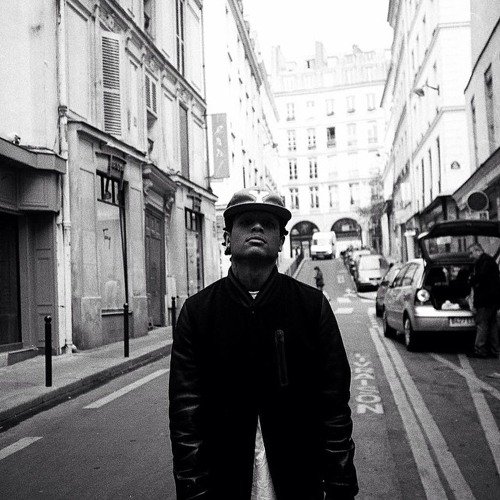
The Hip-Hop culture
Hip-Hop is commonly confused with Rap music as if they were the same thing, when in fact, Rap music is one of several expressions of that culture, but this is completely understandable, since Hip-Hop originates from Starting from a street musical manifestation, cheerful and danceable, in the city of New York at the end of the seventies. In the USA despite the prolonged subjection to the second half of the twentieth century of Afro-descendants, they always enjoyed a relative advantage in terms of learning Western technical forms; while in Venezuela, for example, blacks as well as natives were forbidden to use Western musical instruments, allowing only the use of their own instruments; In the USA, it was just the opposite: the Afro-descendant population was prohibited from making and using musical instruments inspired by African music, allowing instead to learn and execute the use of the different musical instruments of the West, this allowed the birth of rhythms like the Blues, the black contribution to the development of Jazz and Rock and Roll, musical forms as rich and particular as the Gospel, and in general, the marked Afro-descendant contribution to the rhythms of the southern states of the USA.
At the end of the seventies, the fusion and syncretism of different black rhythms, and with a black contribution, such as Rock, Rhythm and Blues, Soul, Funk, Dub and Disco Music gave rise to the popularization of a concept that already it was heard to name from years before: Hip-Hop music. This type of music was born from the radio stations and their live programs with telephone participation of the listeners, where they requested by phone the Disk-Jockey certain songs. The Disk-Jockey becomes an important character of the popular imagination over time, it is a kind of hero or genius who grants wishes; and this importance takes him out of the radio stations abroad, where at public parties in entertainment venues, sports courts, or in the same street, this character "click-discs" or coherently mixes the end of a song with the beginning of another so that the music has no pause; with this practice it is discovered that mixing music produces new music, and this new music, the mixed music is called Hip-Hop. As this music is considered a new genre, the Disk-Jockey conquers the status of musician, and its artifacts the status of instruments.
At Hip-Hop parties, which were mostly in the Bronx sector of New York was danced of course, and thanks to the agility and strength of people of African descent, is born a type of acrobatic dance called Break-Dance, very competitive, with a certain character of duel, where two or more dancers wore their dowries in turns, winning prizes the best of them. Also during these parties, while the mixed music sounded, a microphone was open to the public, so that whoever wanted to sing would do it; and here is the origin of the Rap music, which at that time was nothing but rhymed poetry, completely improvised, that must accompany the rhythm that the Disk-Jockey is weaving. Although the name of Rap would be defined some time later, and this music was present in the Hip-Hop parties, the Rap would later leave the field of the party becoming a musical narrative, poetic, very elaborate and not at all improvised, reaching possess deep emotional contents through which the black identity was expressed and their pains and vexations were exposed by the target, and by the system: criticizing it, exposing it, and in this way, facing it.
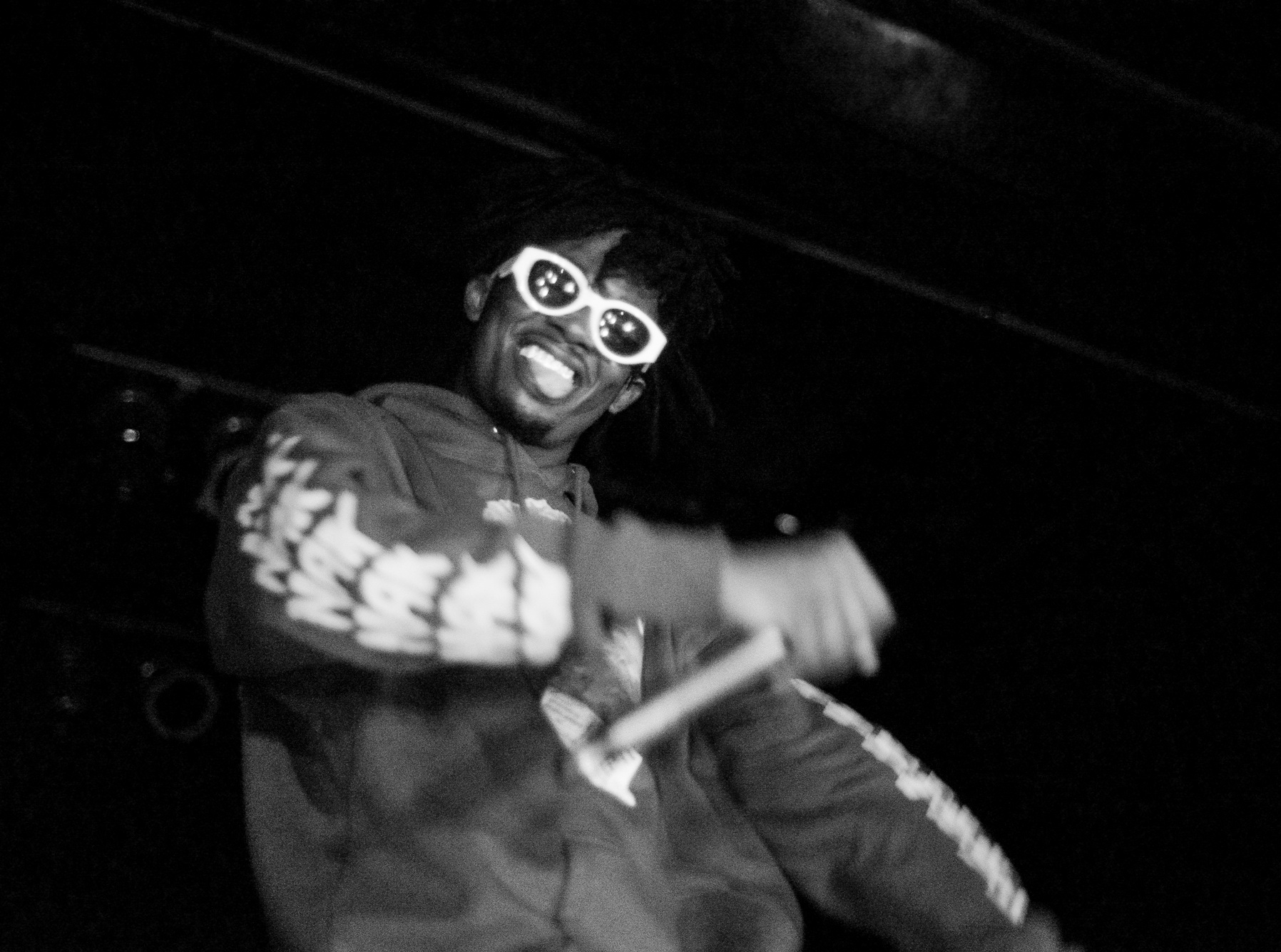
The Hip-Hop culture is born in street parties, made by and for the vulgar, this culture is a fact of street: The black population suffered major vexations; they were forbidden to enter certain spaces, they could only live, study, and work in the worst places, thus perpetuating their closed slavery that continued even after the reforms in the area of equal rights that occurred in the sixties and seventies of the century past; but the street was and still is a free space for them, not very welcoming but free. The blacks of the New York of the seventies, and of the subsequent decades until our days, continued and continue to develop this culture of the street, to the point of contagion; the Hip-Hop culture is no longer an exclusively afro-descendent american manifestation, but because of the fact that Rap music was transformed into a value of protest, resistance, and liberation, through its narratives, this music, and in general all the manifestations of the Hip-Hop culture came to be enjoyed, shared, assumed, and lived, by the oppressed and vexed from the whole world in its entirety: which is very logical and natural; borders are imaginary lines on maps and road signs, but the poor, oppressed, and vexed by the prevailing culture, the established order, and the entrenched power, are the same people everywhere, speak the language they speak; they are from a certain point of view very familiar among themselves, surely an oppressed of Asia and an oppressed of America have more in common with each other, than each of them with a first class citizen of their respective country; and there are streets and neighborhoods in every city in the world, so it is understandable that the Hip-Hop culture spread throughout the planet as an epidemic, especially considering that the middle and lower socioeconomic strata represent almost the entire world population .
Africa Bambataaa, famous DJ and founder of Universal Zulu Nation, is recognized as the first to use the term Hip-Hop to describe a subculture to which this music belonged. The first printed use of the term was in "The Village Voice," by Steven Hager, later the author of a Hip-Hop story in 1984. The roots of Hip-Hop can be found in African-American music, as we have already discussed, and lately in African music. The griots of West Africa are a group of traveling singers and poets who are part of an oral tradition that goes back hundreds of years. His vocal style is similar to that of rappers. Other African-American manifestations such as the Signifying ', The Dozens and the Jazz Poetry are descendants of the griots. Additionally, groups of musical "humor" as Rudy Ray More and Blowfly are considered by some as the grandparents of the Rap. In New York City, interpretations similar to the griots of spoken poetry and music by artists such as The Last Poets, Gil-Scott Heron and Jalal Mansur Nuriddin had an important impact on the culture after the civil rights movement over the years the sixties and the seventies of the last century.
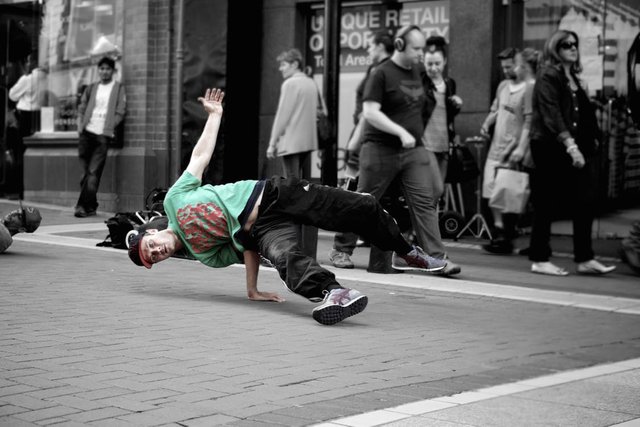
Artistic branch
For the purposes of this work, the Hip-Hop culture comprises at least four divisions, which in turn branch out into particular and specialized artistic expressions: Rap, subdivided into musical performance with the arts of the DJ, the Beat-Box, and the Free-Style; that is improvised singing, with a duelistic character among its participants, where each of them must rhyme better and faster, and also express deep ideas while narrating. The Free-Style is the basis of Rap music, which is now a fact of thoughtful composition, production, and marketing through record companies, but a rapper can not be considered as such if he does not have the ability to free-style. The rappers represent a character built when they sing, therefore, they have pseudonyms or artistic names called Aka. The Beat-Box is the art of the phonetic percussion that accompanies the lyric Rap and supplants the role of the Disk-Jockey; In the most street environment there were no material means to own the implements of the DJ, so they began to emulate the music produced by a DJ in a phonetic way giving rise to this new artistic expression of Hip-Hop.
The Break-Dance is extremely popular and does not merit great exposure; It is a dance where outstanding physical skills of the media are exhibited, with a duelistic character as well; where its participants dance the rhythm of Hip-Hop music in an acrobatic way, in turns, trying at all times not to be overcome in dexterity.
Other less known and popular hip-hop forms, and more contemporary in time, comprise the third division of our catalog; namely, the sports practices associated with this urban subculture: street sports therefore, such as traditional basketball, Roller skating with skates, on the streets and in skating rinks, within the practice of which there were even places of entertainment that they were a hybrid between discotheque and skating rink, where they skated to the rhythm of the mixed music and they danced Break-Dance with skates; or Skate with a skateboard, practiced in the street as well as in places and parks called Skate-Parks or Spots, and finally a very interesting chapter of this sports section; Parkour, as it is known in France, its origin country, or Free-Running by its american denomination: a sport-art of liberation, which consists of training the body in terms of acrobatics, climbing, and sprinting, with the purpose of possessing special abilities for escape to aggressors and captors, overcoming the obstacles of urban constructions with a speed and dexterity impossible to be matched by the forces of public order. A sport whose purpose and ultimate goal is to possess a titanic acrobatic skill to escape from the police and other coercive entities.
And finally, the fourth division of Hip-Hop culture that we especially want to address in the present investigation; the mural art that is the graphic expression of this urban subculture, with unmistakable technical and stylistic characteristics, contentive of subversive visual contents through psychological attack strategies, rooted both in the ancestral African roots as well as in the contemporary war tactics:
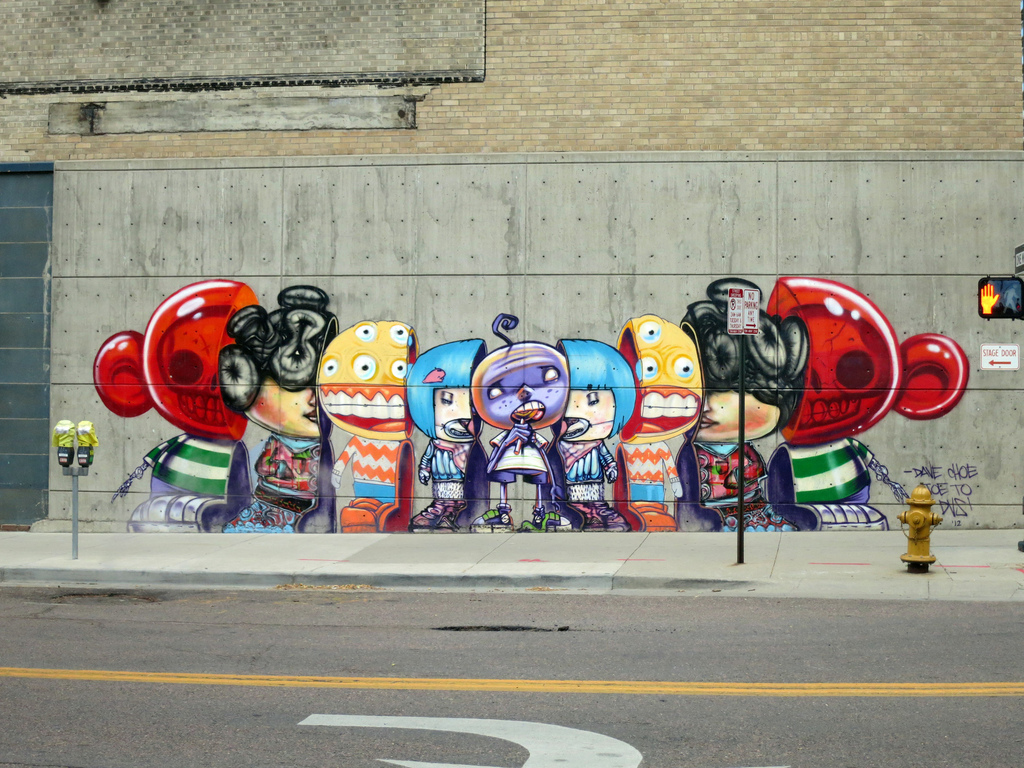
Graffiti
The first thing that we must deal with is the fact of the African character manifested in this expression of Hip-hop, the hunting and warrior culture of the African tribes continues to exert an influence on Hip-Hop, and therefore on Graffiti: that is, There is an ideology, certainly a mythological construction, of African origin, present in the descendant populations of Africans, located in the different countries of the American continent. In Africa when wars occur between tribes or villages, there were and exist warlike forms of intimidation and marking of the territory, as also within these ethnic segments there are symbolic forms to express the coming of age in men, or the status of warrior, and mechanisms similarities become part of the psychological framework of Hip-Hop manifestations. There are tribes in Africa where the age of majority in males is expressed through the exhibition in body clothing of paint, scars, or the bearing of certain amulets; for example, the bearing of certain feathers of birds, that in order to obtain these feathers the male must pass the test of undertaking a long and dangerous journey, alone or with other aspirants, to reach the distant territory where these birds live, hunt them and so get the feathers.
In the symbology of Hip-Hop clothing, very similar things happen, because clothes of recognized brands are used, very expensive; where hats, for example, can be equivalent to African feathers: if a rapper has many expensive caps, or very colorful clothes of high economic value, this is a symbol of his purchasing power, therefore of his status: if a rapper owns these expensive costumes this expresses its high level within the musical production, which as we said today is a commercial fact, as it can also express the following; if a rapper has the purchasing power to dress like that, he also has it to own firearms, therefore, costly clothing intimidates detractors in his possible desire to attack him, as in the African continent the use of certain clothes or Body adornments intimidate the attackers and is a symbol of status and hierarchy, or of strength and ability.
Despite the high solidarity and manifestations of brotherhood present among Hip-Hop practitioners, and despite the hip-hop ideology professing as "should be" the character of honorable ethical behavior known within their slang as Seriousness, it is normal that in the environments where the Hip-Hop culture moves, there are many confrontations; it is a street culture, the street is in itself a hostile environment, where the organization of human life in groups facilitates survival, but creates social tension between the subjects; hierarchies; power relationships; and territoriality and rivalry between groups: hence the fact of gangs, and gangster societies. It should also be noted, that it is common and natural, the amalgam between the way of life of Hip-Hop and illegal or criminal activities such as theft or drug trafficking; that apart from being well-paid occupations to which the most underprivileged social sectors can have access, it is commonly conscious on the part of its actors, the fact that these activities are also an open form of confrontation or belligerence against the established social system; and the spirit of Hip-Hop with its varied expressions of a duelistic character and its critical ideology against power, works well within an environment of open and frontal confrontation.
The warrior and hunter character of the African, and his origin coming from forms of life with more archaic material means, with which he faces a severely hostile environment, could not submit forever to the culture and legality of the society that enslaves them ( exclusion is a modern closed form of slavery), and less, to eradicate the nature of their psyche, so, Afro-descendants, and other excluded (Latinos, Asians, poor and immigrants in general) of urban habitat surely find a virile comfort in cultural expressions such as Hip-Hop with this critical and belligerent position against the established power, and its natural relationship with crime, where for example, an Afro-descendant benefits threefold: 1) expresses his recent inheritance as hunter and warrior, thus identifying himself with the mythology of its African origin; 2) he obtains a higher income than he would achieve by doing the work that society allows and imposes; 3) attacks the system that submitted him and that still tries to subject him, apart from that within the criminal environments associated with the Hip-Hop culture, the courage, skill, and intelligence necessary to achieve compliance with said work of antisocial militancy without being prey of judicial punishment, is awarded with recognition, respect, authority, and status. Credentials, as criminal feats can be called, make them heroes, just as in the ancestral cultures of Africa these same virtues are similarly rewarded with acceptance and social recognition.
We can not continue without clarifying that this research seeks a certain degree of impartiality, we do not intend to make an apology for physical or psychological violence as a form of struggle around political or class ideals; we cant condemn the violent behavior of individuals subjected to sub-human living conditions in their actions to survive.
An attempt is made to elucidate patterns of behavior within cultural patterns; we do not affirm that every individual belonging to the Hip-Hop manifestation sympathizes or practices illegality, at all, but we can affirm with certainty that the majority of Venezuelan delinquents - inevitably coming from neighborhoods, suburbs, and rural areas - count Rap music within the various musical styles that they may like, and they can get to dress up in Hip-Hop style.
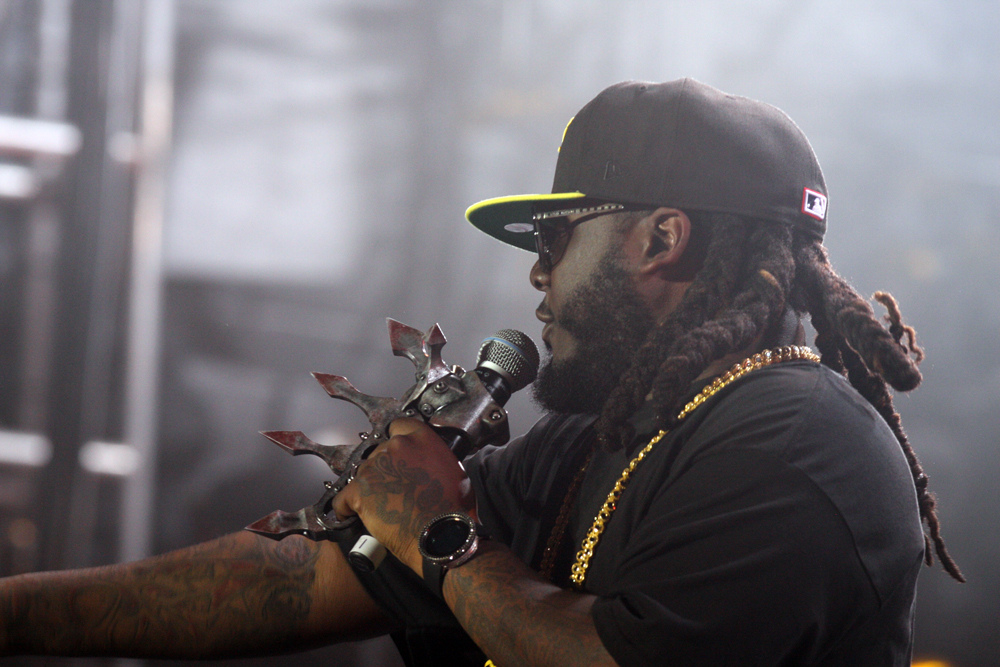
Let us now define the word system within the theoretical-political ideals of at least two urban youth manifestations; Punk, and our object of study, Hip-Hop. The System, now in capital letters, would become the way in which the human being has organized his existence around institutions that define, plan, order, and direct his life; namely, the Western way of the industrial capitalist era, which has produced the kind of republican state that justifies and is originated in the inequalities of power and means of subsistence among its citizens, and is built on the administration of coercion and subjugation socially accepted, which is closely associated with mercantilism, consumerism, and the economic and ideological interests of the ruling classes; Sustained and perpetuated by the behavioral and psychological programming of religion, education, and family. The System is the established power, ordering the life of people through institutions that originate and regulate behavior.
The urban subcultures previously named, among others, conceive their actions as forms of war against the System, operating the diffusion of critical contents from different expressive, artistic, and communication forms, seeking that these messages reach the masses of the most unnoticed individuals in the world. his political self-awareness, within the sectors of the working class population. In the Venezuelan Hip-Hop culture the word "Civil" is common to designate the average citizen; that is not criminals, not "Law"; as it designates the police forces: if they are named Civilians it is because there is clearly a confrontation of which that type of person does not take part; it is not part of the confrontation; but they are the target of certain aggressive communication techniques, because if that population becomes aware of its situation of submission, and abandons passivity, it is propelling social changes to its benefit. Hip-Hop as well as Punk emit constant messages against the System as they also contain in their traditional manifestations, the practice of sabotage and the destruction of public property, different forms of vandalism among which we can clearly include mural graphic art, This is done looking for that apart from issuing a critical content, uncomfortable for its illegal location or for the destruction of the architectural uniformity of the constructions: as ancestral and African as when in war, a tribe makes marks in the territory of the enemy to give account that said territory was invaded, or violate the women of the enemy village in the absence of men; different forms of insulting and intimidating, infringing the borders of the territory, property, or vital space, of the enemy.
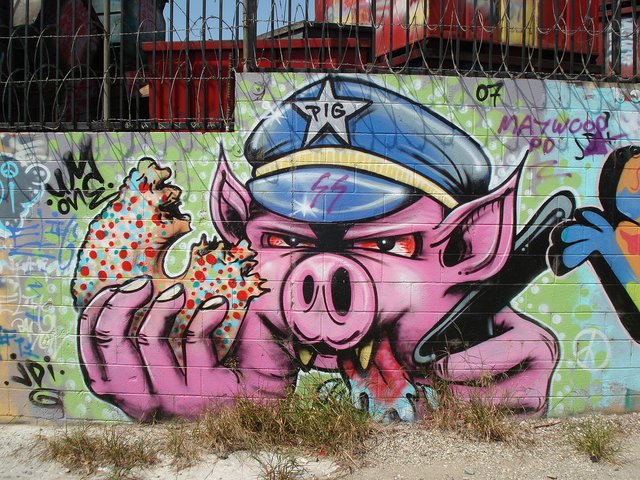
These violations of public space or private property by Graffiti painters, by locating their works in a way that destroys the uniformity of architectural constructions; its chromatic coherence, or when issuing messages against power in the walls of the very precincts of power, is the physical form of struggle, but there is also a psychological form of struggle; and the terrain of this is the psyche of the average citizen, which can be called Civil in the slang of Hip-Hop. When the Graffiti murals, the Stencil painting (small graffiti made from designs emptied in acetate molds), the Sticker (stickers), the Poster (posters), or the Tak signatures (Aka writing with indelible marker, in typefaces abstract, marking territory, and vandalizing public or private property) are located in crowded public places where a large number of people are obliged to observe them, it is usually their strongest countercultural content, since Graffiti takes the opportunity to the forced intrusion in the attention of the spectators, to emit contents and expressive forms of these, that would be censored in any other means of communication or aesthetically accepted social language, and legally allowed; hence, it is an aggressive art, visually powerful in its psychology; his practice promulgates a certain form of communicational terrorism that seeks to destabilize the confidence of the possessors of political and economic power through the insult of violating their territory and ridiculing the effectiveness of their capacity to protect themselves, as well; awakening the conscience of the average citizen facing him burlesque and cruelly with his reality of slavery and alienation, even going so far as to dismiss him to call his attention in relation to the necessary self-consciousness of his deplorable situation, and around the duty to improve his conditions of life in search of greater freedom, confronting the identified enemy, which is the System, antipodal to their interests as citizens and their human rights.
It is equally common, in the content of Hip-Hop graphic art, the presence of messages that, due to their complexity, abstraction, or importance in the need to be transmitted, are subliminally concealed, expressed with subtle suggestions; seeking to attack in the depths of the spectator's subconscious the cultural programming of behavior imposed by the System: it is common to use psychologically strong visual symbols and referents, which are a form of aggression to the psyche of the observer transient, or to values morals inherent to the ordinary citizen of the worker sector, whether of manufacturing, commerce, private bureaucratic work and public works of urban life, or of the mind-reading: it is common for street graphic art to be a vehicle of aggression against civilians, attacking their psyche, insulting them to remain in their condition of alienation. These tactics of street graphic art, of insulting the enemy to make him distrust his power; of making him lose his confidence in himself; as well as the tactic of emotionally destabilizing the population so that it doubts the convenience or legitimacy of its social and cultural reality, they are common in the modern field of contemporary war strategy called Psychological Operations, where different forms of emotional destabilization are sought , instill distrust and fear, weaken the enemy's will, and attack the cultural establishment on which it is based.
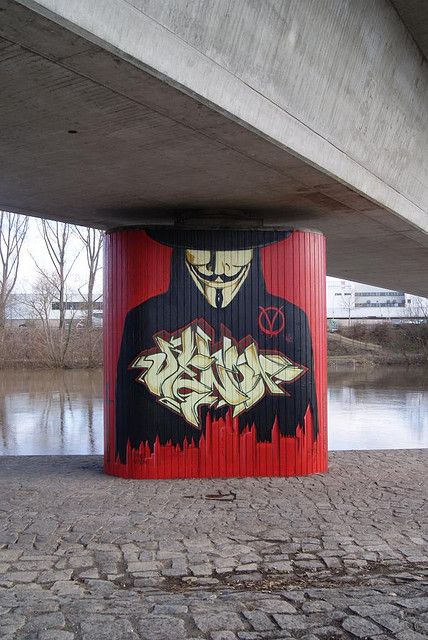
But it should also be noted that apart from these belligerent and countercultural interests, the street graphic art also has within the ethical ideals of its actions -related to the values of strength, solidarity, and honesty proposed as "should be" in the hip-hop ideology - the notion that as an artistic manifestation, full of life and beauty, put color into urban public spaces, wearing visual attractions to walls that without the work of graffiti artists those surfaces and spaces would be visually neutral, aesthetically null , and semantically empty; without any significant aesthetic value for the enjoyment or identity of the citizen: besides being art of the people for the people; of the vulgar for the vulgar; it is a vision of the common citizen of the "self" and of its living conditions, the work of the common citizen through a legitimate aesthetic manifestation of its own. The cold scientistic vision is also a cultural construction of our industrial age; a form of knowledge accepted and promoted by the cultural establishment and although it is clear that it orders, and conceptualizes reality for its more specific and accurate understanding; it is only a cognitive instrument whose methods can approach or be isolated from the truth of things. A group of young people listening to music at full volume can be a social entity marking their territory through sound and expressing their beliefs and constructions around reality, or simply a group of young people listening to music at full volume because of this have a lot of fun and both are true.
.jpg)
Conclusions
The Hip-Hop culture is a form of subversion through art, which expresses in its libertarian ideology and in its ethics of chivalry, features of the mythological construction of African origin referring to the virtue of the warrior. Virtue that is practiced through the militant communicative action of Hip-Hop against the established power, and against socially learned and accepted ways of life and behavior that perpetuate the existence of this power.
photographic sources
https://commons.wikimedia.org/wiki/File:Graffiti_in_Shoreditch,London-CEPT(13804882184).jpg
https://soundcloud.com/jokemtp/joke-niggas-in-paris-freestyle
https://en.wikipedia.org/wiki/Playboi_Carti
https://www.pexels.com/photo/break-dance-break-dancer-city-performance-3156/
https://www.flickr.com/photos/daquellamanera/8385870630
http://www.jber.jb.mil/News/Articles/Article/595868/graffiti-the-right-way/
https://www.flickr.com/photos/evarinaldiphotography/7079740373
https://www.flickr.com/photos/24293932@N00/496980189
https://www.pinterest.com/7THREE2/graffiti/
https://commons.wikimedia.org/wiki/File:Graffiti_in_Shoreditch,London-Elephant_by_Alexis_Diaz(9422258885).jpg
This is unbelievably dope AF. What inspired you to study hiphop?
thanks friend! I'm glad you liked it. i pass into your profile and I saw that you study Hip-Hop too. Well, my interest in Hip-Hop culture began at the time of university; while I was studying cinematography I had some rapper classmates with whom I made a great friendship and I could see that they were honorable, courageous, and sincere people. great friends. With time I started to like his music, and I was the photographer of the rappers of Mérida, a small student city in the Andean mountains of southern Venezuela.
Great Information on Hip Hop and well written. Thanks for this. Dope.
thanks to you for reading buddy, it's cool that you liked it, that makes me want to continue writing here.
Congratulations @demian-gil! You received a personal award!
You can view your badges on your Steem Board and compare to others on the Steem Ranking
Do not miss the last post from @steemitboard:
Vote for @Steemitboard as a witness to get one more award and increased upvotes!